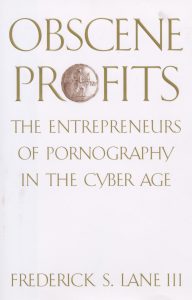The news marks the end of a 40-year run for a video-recording format once hailed as a market leader in picture quality (so much so, in fact, that Betamax was the near universal preference of television studios and video production companies). Unfortunately, mere technical excellence was not enough to protect Betamax’s share of the video-recording market. Just one year after Betamax hit the stores, JVC released its competing format, known as VHS (for “Video Home Service”). The JVC VHS tapes had two significant advantages for consumers: they could hold significantly larger amounts of content, and they were cheaper. Those benefits, combined with Sony’s widely-acknowledged failure to effectively market Betamax, helped JVC capture 40% of the videocassette market in a single year and a stunning 90% over the following decade.
There is a wide-spread rumor (which, I am happy to say, I did not help promulgate in Obscene Profits) that the pornography played a direct role in the triumph of VHS over Betamax in the consumer marketplace.
One variation of the rumor is based on the belief that Sony simply refused to permit its recording equipment to be used for producing and distributing adult content. While there are some blanket assertions online that Sony did in fact impose restrictions on who could use its Betamax equipment for mass production, others fairly question how Sony could have prevented adult content producers from creating Betamax versions of their adult videotapes.
More importantly, a variety of other companies (Toshiba, Pioneer, Aiwa, to name just a few) also marketed equipment capable of recording in the Beta format, so the adult industry had no lack of potential sources of equipment. And there is evidence (albeit anecdotal) that adult videotapes were available in the Betamax format even before VHS.
The more common version of the rumor was apparently launched by attorney Peter Johnson, who wrote in an article for the Federal Communications Law Journal in 1996 that:
[t]he victory of VHS over Betamax, and the triumph of video rental and purchase over time-shifting, is a rare example of pornography specifically adopting a product and a method of retailing that drove its competitor from the market.
Unfortunately, there isn’t any support for Johnson’s conclusion that adult content producers specifically chose VHS over Betamax and thus killed off Sony’s format. Instead, what happened was that consumers chose VHS for two simple reasons — cost and convenience — and adult content producers followed the market.
As I pointed out in Obscene Profits, a home videoplayer produced by JVC was several hundred dollars cheaper than the consumer equipment produced by Sony. While the recording and playback quality of the Beta format was unquestionably better than VHS, it wasn’t several hundred dollars better. As a result, sales of VHS equipment rapidly dwarfed those of Betamax. It simply made sense for adult companies to focus on producing and distributing VHS tapes since the pool of potential renters and buyers was so much larger. Moreover, the larger capacity of VHS tapes offered consumers more content.
I believe that the decade following the introduction of the video cassette recorder marked the most profound technology-driven shift in cultural mores until the widespread adoption of the cameraphone two decades later. Here’s my summary from Obscene Profits (p. 52):
The growth in the number of potential pornography producers was more than matched by the growth in the number of potential outlets for sexually explicit video. In the early 1970s, at the end of the so-called Golden Age of Pornography, a feature-length adult film could be seen on 1,200 to 1,300 screens, roughly 1,000 of which were under the control of the Pussycat Theater chain. By contrast, there were tens of thousands of screens on which a given loop might be seen. However, the distribution channels for loops were even more tightly controlled than those for adult films. In part because of the cost, but also in part because of the limited number of outlets, only about 100 or so feature-length adult films were produced and distributed each year. A chief result of the small number of adult titles produced each year was that amateur production and distribution of sexually explicit film was essentially limited to the underground 16mm and 8mm markets.
The introduction of the VCR, however, opened up completely new distribution possibilities for adult movies. Instead of playing on a few hundred full-size screens or even tens of thousands of peep show screens, an adult movie can now play on any of about 81 million screens around the country (based on surveys showing that a little more than eight out of ten households own a VCR).
In the fifteen years since Obscene Profits was published, the technological landscape, of course, has shifted a bit. Adult video content can now be viewed on every type of digital device capable of connecting to the Internet, which puts the total number of screens in the tens of billions. We are only beginning to assess the impact of those changes.
